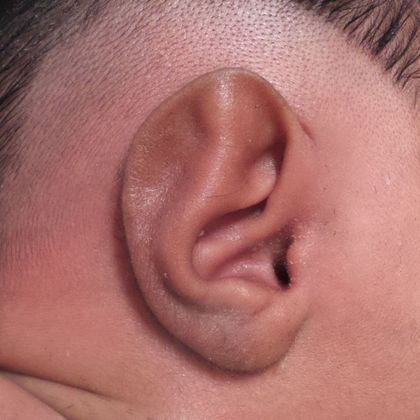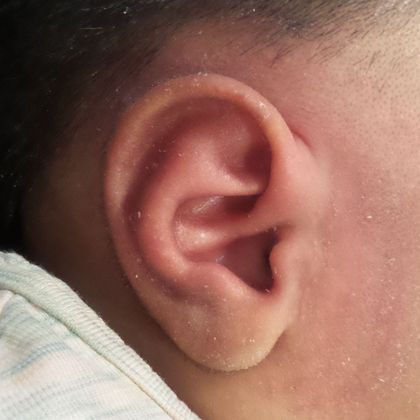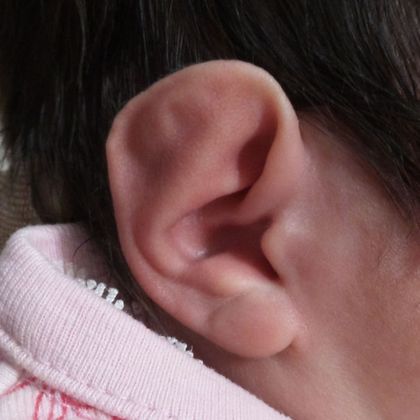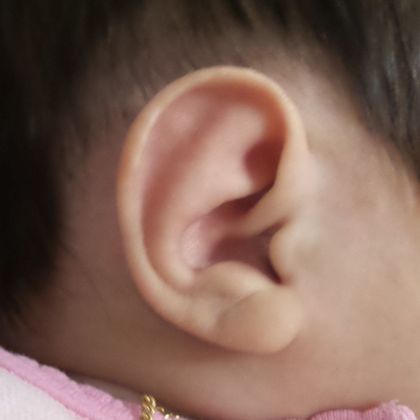Flat helix ear deformities are one of the many congenital ear deformities that exist. Parents will often call the office and describe their “baby’s ears are flat” or their “baby’s ears are uncurled”. Parents will google “flat ear cartilage” to figure out the cause and find a method of correction. At Dr. Jandali’s office, he can provide non-surgical treatment for flat helix ear deformities in newborns using ear molding.
What Are Flat Helix Ear Deformities?
Flat helix ear deformities are a type of congenital deformity causing the helix, or upper ear ridge, to be abnormally formed. The ear appears flat and lacks the inward curl that defines the ear’s shape. It’s sometimes associated with Stahl’s ear deformities with the presence of a third crus of the antihelix. The third crus is an extra fold of cartilage extending to the outer helical rim and flattening it. Flat ear deformities can lead the ear to be undefined in its appearance.
Currently, the cause of flat helix ear deformities is unknown. However, flat helix ear deformities are also present in Stahl ear deformities, and both conditions affect the natural appearance of the ear. While this condition doesn’t cause hearing loss or difficulty, it’s a very visible deformity that can lead to mocking and ridicule of a young child. Flat ear cartilage deformities are best corrected non-surgically with ear molding.
Non-Surgical Correction in Babies with Flat Helix Ear Deformities
Flat ear deformities are considered rare among babies and are scarcely reported. However, in their earliest stages, flat helix ear deformities can be treated using ear molding, a non-surgical treatment that helps reshape the ear using a silicone prosthesis.
Dr. Jandali can perform baby ear shape correction by placing the prosthetic along the helical rim to curl and reshape the cartilage without needing surgery. The device is worn on your baby’s ear for at least four weeks, reshaping the ear to a normal appearance.
For those seeking a non-invasive treatment option for their newborn’s ear condition, ear molding can be the right choice. Ear molding has multiple benefits that make it the best option for addressing ear deformities without the risk of surgery, including:
- Responsive: Your baby’s ears will be malleable and pliant during the first six weeks of their life. During this period, ear molding is highly effective. However, they will become increasingly rigid as the weeks continue to pass, so treatments must be started early after birth.
- Painless: The malleable nature of your newborn’s ear in these early weeks also ensures the process is not painful.
- Effective: The full treatment period is four to six weeks in length. Progress is checked at appointments every 2 weeks. Adjustments are made to obtain the best result.
- Non-Surgical: As there are no incisions, anesthetic, or downtime needed to achieve results, ear molding is safer than surgery. Ear molding does not affect your baby sleeping, lying on his or her side, or nursing. Ear molding does not affect newborn hearing development as the ear canal is never covered during treatment.
Ear Molding for Babies with Flat Helix Ear Deformities
If you have a newborn with flat helix ear deformities, non-surgical ear molding can help. Dr. Jandali offers non-surgical ear molding treatment at his practice in Connecticut. Additional information is available by contacting Dr. Jandali to discuss the available options for treating your newborn’s ear deformity.
Flat Helix Ear Gallery




